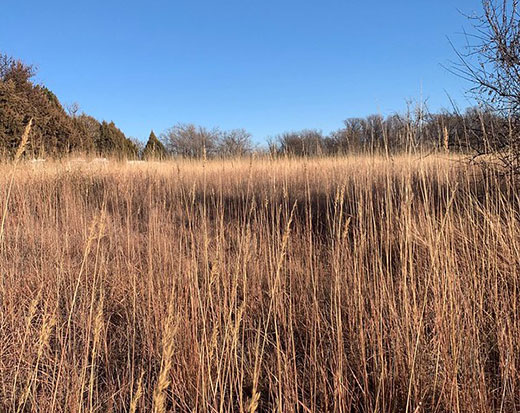
Standing fuels, including grass pictured here in Thomas County, are present across much of the state after above normal precipitation in 2019. Despite recent moisture, fuels are drying quickly which has increased fire danger. | Download this photo.
Fire season returns to Kansas
Kansas Forest Service, K-State Mesonet advise Kansans to prep for potentially active fire season
March 5, 2020
MANHATTAN, Kan. – Rising temperatures and breezy conditions are quickly drying fuels across the state, increasing concerns for an active fire season in Kansas.
“Despite recent moisture, Kansas's primary fuel – grass -- is abundant due to last year's above normal precipitation,” said Chip Redmond, Kansas State University assistant meteorologist.
The timing of future precipitation between dry frontal passages will determine how active this fire season is, Redmond said.
Fire season in Kansas usually runs from early to mid-March through mid-April in the spring, and it appears to be getting a quick start this spring. A number of counties have already fought multiple wildfires in recent days, with a handful becoming large and challenging.
“Regardless, green up is only in the initial stages in far southeast Kansas. The potential for active fire behavior will remain through April as dead grass remains vertically aligned and volatile during any period of warm/dry and windy conditions,” Redmond said.
Eric Ward, the assistant fire management officer for the Kansas Forest Service, said that multiple reports from fire departments and people conducting prescribed burns this winter and spring have indicated that fire behavior has been much more challenging and difficult to control than the weather conditions would have indicated.
“Fire departments should be vigilant and prepared to dispatch more resources than they typically would in the event of a wildfire,” Ward said. “Landowners conducting prescribed burns are urged to carefully check the fire weather forecast, available on each National Weather Service website, prior to attempting any burn.”
Landowners are encouraged to check weather for at least three days following any planned burn, as it has not been uncommon for an ember to get whipped to life by dry winds a day or two after a prescribed burn.
Ward said homeowners in rural areas, or any area where natural vegetation borders their property, should clear debris, keep their lawn mowed, clean out gutters and corners that collect fallen leaves, and remove anything that a blowing ember could light on fire and threaten their home.
For more information on protecting your property, contact the Kansas Forest Service or your local fire department.
About the Kansas Forest Service
The Kansas Forest Service is the nation’s fifth oldest state forestry agency. The agency serves rural landowners, communities, rural fire districts, forest and arboriculture industries, and citizens of the state through its Conservation Tree and Shrub Planting, Fire Management, Community Forestry, Rural Forestry, Marketing and Utilization, and Forest Health programs. The Kansas Forest Service state office is located in Manhattan, Kansas, just west of the campus of Kansas State University. The Kansas Forest Service is housed as an independent agency within K-State Research and Extension. The agency receives its direction from a mission statement that reads: “Care of natural resources and service to people through forestry.”

